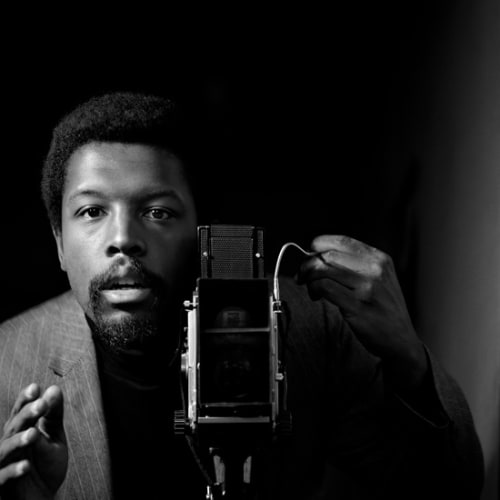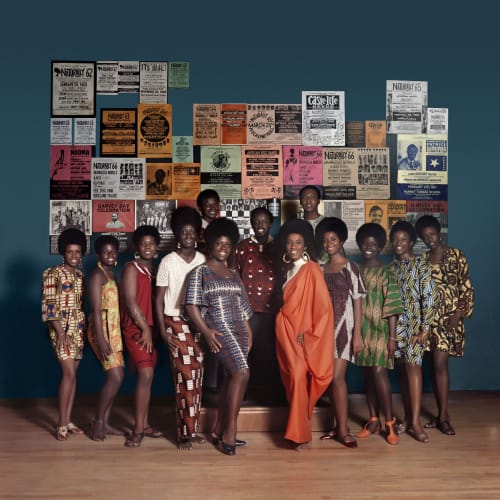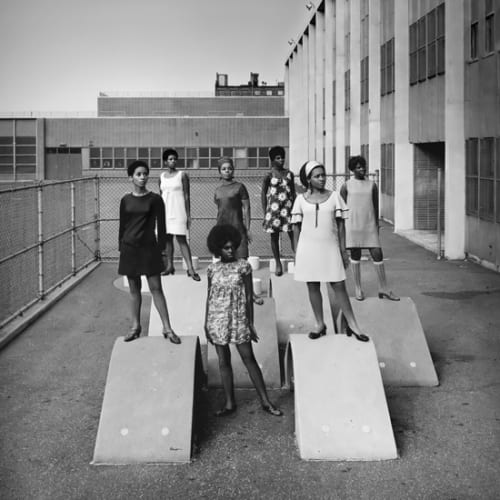In this diffuse era of the internet, as we learn to look beyond mainstream narratives funneled through institutional power, the contributions of under-recognized cultural caretakers like photographer Kwame Brathwaite has increased in value. To that end, Black Is Beautiful: The Photography of Kwame Brathwaite, an exhibit now showing at Los Angeles' Skirball Center, and its companion photobook, Kwame Brathwaite: Black Is Beautiful, are worth their weight in Black gold.
Brathwaite's images crackle with swagger, intellect, camaraderie and achievement, visualizing unity and community through iconic and off-the-radar figures from the late 1950s and '60s. They radiate with life. His subject matter offers an insider's gaze on a quasi, Africanized second Harlem Renaissance. Photographs of the 1958 Randall's Island Jazz Festival, bathers at the Jacob Riis Park beach, and political rallies, as well as candids, studio portraits, and live performance shots of luminaries such as Miles Davis, Max Roach, Abbey Lincoln, Dizzy Gillespie and a host of black models, all illuminate Brathwaite's vision.
Born in Brooklyn and raised in the Bronx along with two brothers, Brathwaite cultivated an eclectic worldview. Significant influences included his parents roots in Barbados; his father's design skills as a tailor and painter; summers spent in the elite, Black east coast enclaves of Sag Harbor and Martha's Vineyard with a focus on art; and, inspiration from jazz and the teachings of Marcus Garvey. All of these sensibilities and experiences culminated in a lifelong allegiance to the directive, Black is Beautiful.
In the introduction to Brathwaite's monograph he writes, "I focused on perfecting my craft so that I could use my gift to inspire thought, relay ideas, and tell stories of our struggle, our work, our liberation." And later adds, "People like to say, 'Trust the process.' Not only did I trust it - I was passionate about the work that it took. Don't just trust it: pursue it, love it, and it will give you the truth."
Kwame did so with vigor. In 1956, just before his 20th birthday, he and his brother Elombe Brath founded the African Jazz-Art Society and Studios (AJASS), a collective of Black artists, playwrights, designers and dancers. In 1962 he launched, Grandassa Models, a modeling agency for Black women, many of whom designed their own clothing and accessories. Brathwaite's photographs and the creative culture he helped to cultivate are infused with both literal and abstracted elements of Garvey's Pan-Africanism, and the instrumental virtuosity, improvisation, harmonic structures and melodies of modern jazz. An ecstatic, liberated form of beauty full of grounded vitality can be found throughout his work.
In her essay for Kwame Brathwaite: Black Is Beautiful, Tanisha C. Ford succinctly contextualizes Braithwaite's position within Black movements of the 1960s: "They were calling themselves African and Black long before those terms became common in American racial vernacular. AJASS members were the woke set of their generation."
A seamless convergence of creative output and activism, intersectional aesthetics, Pan-African thinking and embrace of Afro-diasporic culture set the stage for Brathwaite's exploration of "creative power" and his life's work. "As The Keeper of the Images, my goal has always been to pass that legacy on and make sure that for generations to come, everyone who sees my work knows the greatness of our people," he writes. The presentation of Brathwaite's oeuvre to broader audiences offers up a supremely tantalizing time capsule of Black history that will undoubtedly inspire the breadth and depth of Black visual archives and creativity forevermore.




